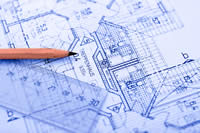Difference between Architect and Engineer
Key Difference: Architects are people that are trained to plan, design and oversee the construction of the buildings. Engineers are people that are responsible for applying mathematical and scientific knowledge in order to develop technical solutions for a problem.
Most people know that architect and engineering are two different fields of study and profession and that architects are associated with buildings and engineers with computers and software. This is actually just a small part of the profession. Although this is correct, it is only a small part of what makes up the whole definition. Architects are often regarded as designers while engineers are considered as builders. Let’s further differentiate these two terms and professions.

Architects are people that are trained to plan, design and oversee the construction of the buildings. They are often the mastermind behind the whole operation. Though most people automatically assume that architects are limited to designing buildings, it is a term that covers more than just that. An architect’s job entails designing the building, maintaining the aesthetic appeal of the building, allocating space usage surrounding the building and finally overseeing the construction. They must also ensure the safety and practical utility of the building. There are various types of architects, including those who design machinery, naval, software, hardware, etc. The term ‘architect’ is derived from the Latin word ‘architectus’, which originates from Greek word ‘arkhitekton’ literally meaning “chief builder” when translated (i.e. ‘arkhi’ = chief; ‘tekton’ = builder). Dictionary.com defines ‘architect’ as, “a person professionally engaged in the design of certain large constructions other than buildings and the like; the deviser, maker, or creator of anything.”
Originally, the design and construction of buildings and places were done by artisans, stone masons and carpenters. There was no clear distinction between an architect and engineer until modern times. In many places, including Europe, architects and engineers are often used interchangeably and regarded as the same. Modern architects must be qualified with a proper education, degree and licenses for practicing architecture. The architect must also go through a period of training under a proper architect before he can start his/her own practices. These precautions are taken as the decisions that architects make can affect the safety of the people. The practical, technical and academic requirements vary depending on the jurisdiction.

Engineers are people that are responsible for applying mathematical and scientific knowledge in order to develop technical solutions for a problem. Engineers are often associated with designing and developing software and hardware; however the term engineering covers a whole lot more. Engineers are responsible for designing materials, systems and structures while considering practicality, safety and cost. National Society of Professional Engineers defines ‘engineering’ as, “…the creative application of scientific principles used to plan, build, direct, guide, manage, or work on systems to maintain and improve our daily lives.” There are various different types of engineering including chemical engineering, aeronautical engineering, computer hardware engineering, computer software engineering, mechanical engineering, automotive engineering, etc. Dictionary.com defines ‘engineering’ as, “the art or science of making practical application of the knowledge of pure sciences, as physics or chemistry, as in the construction of engines, bridges, buildings, mines, ships, and chemical plants.”
Most engineers specialize in one or more fields when studying. Engineering is believed to have a base in applied sciences and research and development. They often are hired to design and construct products or structures, keeping in mind the practicality, safety, feasibility and cost of the project. According to Engineering: Fundamentals and Problem Solving book, most “…of an engineer's time is spent on researching, locating, applying, and transferring information.” When studying to become an engineer, a person must take up general engineering which includes courses in mathematics and science, before being allowed to specialize in a select field. Similarly, engineers must also acquire a degree; pass examinations as well as train before they can start out on their own.
In terms of direct comparison to architects, the field which includes building structures is known as structural engineering or civil engineering. The architect is simply limited to the layouts and the designing of the aesthetic appeal of the building; however engineers are responsible doing the math behind the whole structure. They oversee the feasibility of construction, if the building can be built in the way it is designed and being in charge of how much materials are required and deployed for construction. The architects must also keep follow the local rules of the place where the structure is being built, such as how many stories can a building be before an extension permit is required, the legally defined distance between two walls or ceilings and the floor, etc. In terms of designing structures such as bridges, flyovers, etc. a structural engineer is solely responsible for the designing as well as the construction of that particular structure. In short, architects are the vision behind the project, while the engineers are the brain.
|
|
Architect |
Engineer |
|
Definition |
Architects are people that are trained to plan, design and oversee the construction of the buildings. |
Engineers are people that are responsible for applying mathematical and scientific knowledge in order to develop technical solutions for a problem. |
|
Education required |
Varies depending on jurisdiction; however a degree in architecture, passing examinations as well as training is required. |
Engineers require a basic engineering program, before they are allowed to specialize. They must pass exams and attain a degree depending on their specialization. |
|
Competencies |
Technical knowledge, building design, planning and management skills |
Mathematics, scientific knowledge, management skills |
|
Professional name |
Architect |
Engineer |
|
Activity sectors |
Architecture, real estate development, urban planning, construction, interior design and Civil Engineering. |
Applied science |
|
Fields of employment |
Government for developing certain kinds of areas, Real estate planning, etc. |
Research and development, industry, business |
|
Related jobs |
Architect, Interior Designer, Constructor. |
Scientist, Architect, Project manager |
Image Courtesy: architectinperson.wordpress.com, powerjobsdirect.com









Comments
I believe that this article does a great disservice to th public, most of whom already misunderstand the role of the structural engineer in building design. First, an architect that understands structural analysis and design is very rare in modern times. This is generally because the academic and hands-on time involved in attaining the skills required to perform architectural
functions precludes the simultaneous learning of complex structural engineering skills. Those architects that are competent to design structures must possess duel degrees requiring many years of education and experience under both a licensed architect and structural engineer. For this reason the two professions are normally separate. With this in mind, it it's not within the domain of the architect to oversee the construction of a building structure. This responsibility generally falls to the structural engineer who designed the structure. Field oversight of some aspects of erection schedules, subcontractor progress and quality are generally performed by the General Contractor.
Also, to depict the structural engineer as nothing more than a problem solver or manager is to detract from the true significance of the role he plays in the building design process. The structural engineer is responsible for the life safety of the public that will use the structure. He is also unresponsive for the serviceability of the structure and the assurance of a reasonable economic life of the structure. It is true that a structural engineer must possesses good management skills. But this is only a fraction of his overall responsibilities.The accomplishment of these responsibilities requires intensive education and training. It is typical for a structural engineer to spend ten years in university study and under the supervision of a licenced structural engineer before even becoming eligible to sit for the state board exams. There are usually three board exams required to obtain a license to practice structural engineering for a total of 32 hours of exams.
Finally, after nearly 35 years as a practicing structural engineer I have never seen any architect perform any civil engineering work unless he has a licenced civil engineer on staff. It is true that in times long ago the architect and engineer were one in the same. However, in modern times, these professions are far more complex and require much broader knowledge for a single professional to do it all. It is not my intention to downplay the importance of architecture. However, the General public is already quite ignorant of the function of the structural engineer. I do not wish to see their misconceptions made worse.
Steven J Thomas...
Thu, 07/03/2014 - 22:02
Add new comment